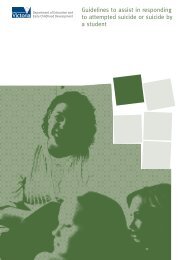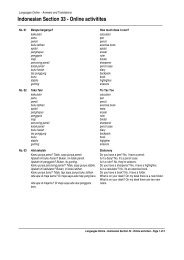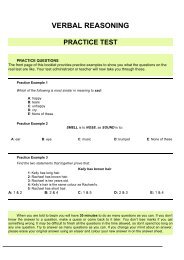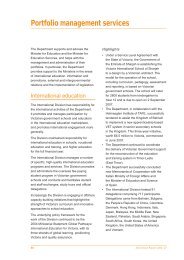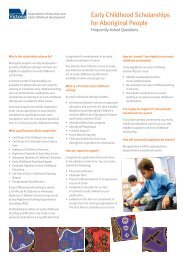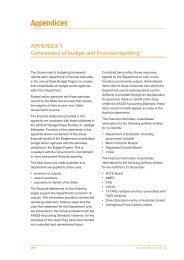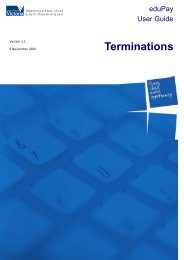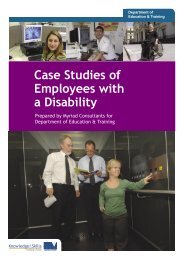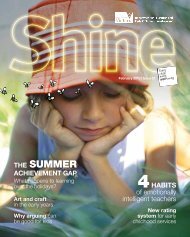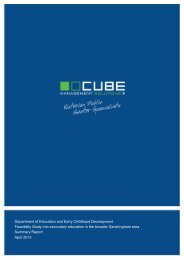November 2009 Vol. 1, Issue 10 (PDF - 16.2Mb) - Department of ...
November 2009 Vol. 1, Issue 10 (PDF - 16.2Mb) - Department of ...
November 2009 Vol. 1, Issue 10 (PDF - 16.2Mb) - Department of ...
You also want an ePaper? Increase the reach of your titles
YUMPU automatically turns print PDFs into web optimized ePapers that Google loves.
education’ ties work or career requirements to the curriculum<br />
(e.g. the maths taught is necessary for the student to succeed in<br />
a particular job).<br />
What is the best way to provide this program?<br />
The primary socialisation context for all students – including<br />
adolescents with disabilities and those with EBD – is the school<br />
system. Something that amazed me during the years I directed<br />
projects that provided transition services to adolescents with EBD<br />
was that the young people who dropped out <strong>of</strong> school <strong>of</strong>ten spent<br />
more time around school than when they were enrolled. That<br />
attraction to be around peers in the school setting is something we<br />
should use to encourage those young people to remain in school<br />
and to be included in meaningful school experiences that combine<br />
employment and academic work.<br />
There are two great challenges in providing this type <strong>of</strong> instruction.<br />
First, to have real work experiences students must be allowed and<br />
encouraged to leave school and engage in work in the community.<br />
Second, educational staff also must be free to leave the school setting<br />
to place students in competitive employment; <strong>of</strong>fer support to<br />
employers, students, and their families; coordinate social services<br />
from community agencies, and then work with teachers to <strong>of</strong>fer<br />
tailored instruction relative to each student’s needs and goals for<br />
after leaving high school.<br />
What training is required for teachers and<br />
education support staff?<br />
For educators to be effective and efficient in the high school/<br />
transition model they must have several unique skill sets that are not<br />
Xxxx<br />
Shine 55<br />
included in traditional educator training programs. Specifically, they<br />
need a working knowledge <strong>of</strong> the competitive employment system;<br />
how to approach employers to establish work placements for their<br />
students; knowledge <strong>of</strong> the community-based social system; how<br />
to access those services for the students with whom they work; and<br />
skill in helping students plan their transition from school into adult<br />
roles. The academic skills educators need would then relate to the<br />
future-oriented focus <strong>of</strong> the students’ career and life goals and how to<br />
integrate job and career requirements into academic instruction.<br />
How can partnerships contribute to pathways<br />
for young people?<br />
A central assumption <strong>of</strong> the high school/transition model is that by<br />
including family members, employers and agencies in a student’s<br />
school-based program, those supports and avenues will be solidified.<br />
In other words, the social service supports that the students will<br />
need later should be established before they leave school. Students<br />
will also be able to access post-secondary education and/or<br />
employment that they select as a result <strong>of</strong> the carefully planned and<br />
informed experiences they had while in secondary school. In the<br />
projects I directed for adolescents with EBD, we found that the<br />
students were frequently hired by employers with whom they were<br />
placed as students, or entered post-secondary programs that they<br />
explored while in our programs.<br />
Pr<strong>of</strong>essor Mike Bullis is the Dean <strong>of</strong> the College <strong>of</strong> Education and<br />
Sommerville-Knight Pr<strong>of</strong>essor <strong>of</strong> Education, Secondary Special Education<br />
and Transitions Research at the University <strong>of</strong> Oregon in the United<br />
States. He was also a keynote speaker at the <strong>2009</strong> AASE/PASS conference.<br />
Email Pr<strong>of</strong>. Bullis at bullism@uoregon.edu<br />
Innovative<br />
Student Desk<br />
Designs<br />
Woods Furniture Pty Ltd<br />
PHONE 03 9316 0600<br />
FAX 03 9316 0611<br />
FrEEcAll 1800 004 555 Australia only<br />
www.woodsfurniture.com.au<br />
For classrooms,<br />
libraries,<br />
intensive teaching,<br />
reading recovery,<br />
group work<br />
IMAGE BOUND / WOOD_3714 SHN<br />
As well as an Asian performance,<br />
Asia Raya has developed<br />
performances around particular<br />
countries. There is “China focus”,<br />
“Pen-tawasik” from Indonesia , and<br />
“Japan focus”.<br />
Asia Raya also provides workshops,<br />
where your students will be engaged<br />
in “hands-on” sessions, where<br />
they learn<br />
a dance,<br />
music or<br />
martial art<br />
form from<br />
Asia .<br />
Asia Raya: Asian music and dance<br />
workshops to excite your students!!<br />
Ph/fax: (03) 5439 2678<br />
email: info@asiaraya.com.au<br />
www.asiaraya.com.au



